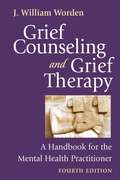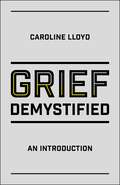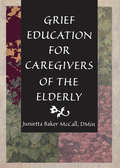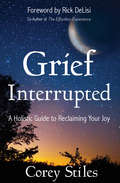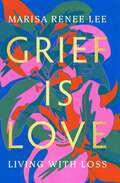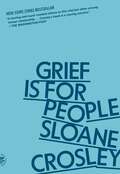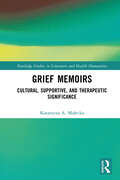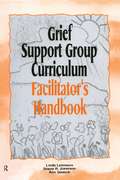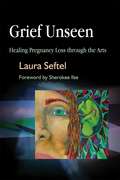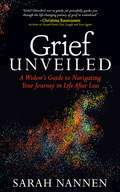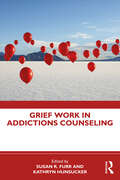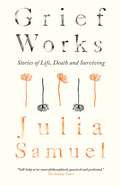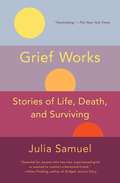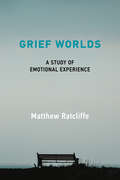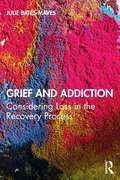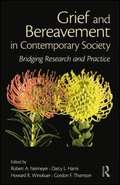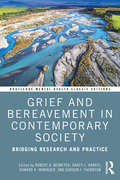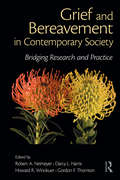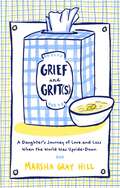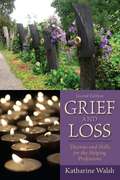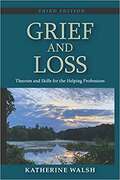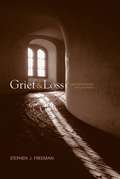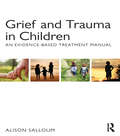- Table View
- List View
Grief Counseling and Grief Therapy: A Handbook for the Mental Health Practitioner (4th Edition)
by J. William Worden<p>Grief affects different people in different ways, most emerge from mourning in a healthy manner but for some the death of a loved one can cause intense emotional pain that is difficult to recover from. This type of grief can often surface as an underlying cause of physical and mental health problems requiring professional treatment. <p>This highly anticipated fourth edition builds on the success of the previous editions which received worldwide acclaim for their sensitive, insightful, and practical approach to grief counselling. Worden incorporates emerging theories and cutting edge research into this fully revised edition which includes: <p> <li>a new chapter on the mourning process discussing the personal and <li>social difficulties that shape mourning <li>detailed guidelines for approaching special types of grief including <li>suicide, sudden death and miscarriage <li>an updated version of the Task Model.</li> <p> <p><i>Grief Counselling and Grief Therapy</i> is an essential resource for everyone working with the bereaved, from those just entering the field, to seasoned practitioners.</p>
Grief Demystified: An Introduction
by Caroline LloydBeing able to offer support to the bereaved is an important part of many frontline professions, such as nurses, teachers, funeral directors and anything in between. Yet very little theoretical information about grief has filtered down into mainstream knowledge, and what has is often misinterpreted. Giving an accessible introduction to modern day grief theory, this book is the perfect guide to grief for the lay reader, or griever curious to how their grief works. Debunking commonly believed myths with information on how grief can vary from person to person, advice on communicating with the bereaved and details on the different kinds of grief, this book is an essential read for anyone working with the bereaved.
Grief Education for Caregivers of the Elderly
by Harold G Koenig Junietta B MccallThrough firsthand accounts and research, Grief Education for Caregivers of the Elderly focuses on the education, training, and support of individuals who care for the elderly. This book provides caregivers with methods to cope with grief and loss and will help educators design programs that meet the needs of their consumers: the elderly and their families, friends, and service providers. From Grief Education for Caregivers of the Elderly, you'll learn how to cope with the stress and emotions of caregiving and improve the quality of services to your patients. With an emphasis on caregivers of the institutionalized elderly and the special services provided by clergy, chaplains, and pastoral counselors, Grief Education for Caregivers of the Elderly offers the caregiver or educator several model workshops focusing on grief, loss, and bereavement care. Grief Education for Caregivers of the Elderly contains proven methods and strategies that will sharpen and enhance your caregiving skills, including: focusing on the emotional responses and phases of dying, including denial, anger, and acceptance, to help patients deal with death considering physical and administrative atmosphere and your elderly population when setting goals and designing workshops to provide optimal patient/resident care discussing the themes of grief and loss, stress management, handling change, and promoting self-care for caregivers in workshops and through self-evaluations developing workshops that open with grief history surveys and attitude checklists, discuss normative development and issues of old age, and have themes based on the biological, psychosocial, and spiritual needs of the elderly person providing caregivers with an opportunity to practice what they have learned through case studies, simulated role play, open discussions, and care plan designing thinking about your own mortality and learning about your feelings and ideas of growing oldUtilized at a psychiatric nursing home facility of New Hampshire Hospital, the workshop exercises in Grief Education for Caregivers of the Elderly have allowed caregivers to express personal feelings; talk about beliefs and experiences; learn about biological, psychosocial, and spiritual processes of grief and phases of bereavement; and apply these understandings and insights into typical caregiving situations. Grief Education for the Caregivers of the Elderly gives you the framework for such a program, using vignettes, composite case material, poetry, and a holistic approach to health care to emphasize the importance of your emotional health and enhanced care of the elderly.
Grief Interrupted: A Holistic Guide to Reclaiming Your Joy
by Corey StilesA heartfelt guide for grieving mothers, from someone who has found her way out of the pain and darkness of this uniquely difficult loss. None of us escapes life without experiencing grief in one form or another. But the journey of grieving parents, specifically that of the grieving mother, is something no one can imagine unless they have lived it. Is there a way through? Is it possible to live vibrantly again, to find joy and purpose in life after your teenage child has passed on? Grief Interrupted is a letter of love, hope, and healing from one mother in grief to another. Corey Stiles, who lost her seventeen-year-old daughter, has walked the path, and her words will inspire you to reclaim your joy. With Corey as your guide, start your journey to a new normal where you will create space for both sorrow and joy to reside within you, without crippling you. On this courageous sojourn, you will rediscover the magic and wonder of life while still honoring your loved one who has transitioned to heaven. Grief Interrupted is like a personal healing retreat for grieving mothers. If you&’re ready to move out of the dark, painful sea of grief and into the warmth and light of joy, this is your starting point. While this is a journey only you can set out on, you are not alone. You have someone to guide you, to encourage you, and to walk alongside you. And as difficult as it may be to believe right now, you can be happy again.
Grief Is Love: Living with Loss
by Marisa Renee LeeA trusted grief expert shares advice on how to navigate the loss of a loved one in this incisive and compassionate guide: &“calm, lucid prose… humanizing exploration of coping with the life-changing tides of loss&” (Kirkus Reviews).In Grief is Love, author Marisa Renee Lee reveals that healing does not mean moving on after losing a loved one—healing means learning to acknowledge and create space for your grief. It is about learning to love the one you lost with the same depth, passion, joy, and commitment you did when they were alive, perhaps even more. She guides you through the pain of grief—whether you&’ve lost the person recently or long ago—and shows you what it looks like to honor your loss on your unique terms, and debunks the idea of a grief stages or timelines. Grief is Love is about making space for the transformation that a significant loss requires. In beautiful, compassionate prose, Lee elegantly offers wisdom about what it means to authentically and defiantly claim space for grief&’s complicated feelings and emotions. And Lee is no stranger to grief herself, she shares her journey after losing her mother, a pregnancy, and, most recently, a cousin to the COVID-19 pandemic. These losses transformed her life and led her to question what grief really is and what healing actually looks like. In this book, she also explores the unique impact of grief on Black people and reveals the key factors that proper healing requires: permission, care, feeling, grace and more. The transformation we each undergo after loss is the indelible imprint of the people we love on our lives, which is the true definition of legacy. At its core, Grief is Love explores what comes after death, and shows us that if we are able to own and honor what we&’ve lost, we can experience a beautiful and joyful life in the midst of grief.
Grief Is for People
by Sloane CrosleyNamed a Best Book of the Year by Vogue, TIME, The Washington Post, The Boston Globe, Esquire, NPR, Elle, Library Journal, LitHub, Oprah Daily, Publishers Weekly, Chicago Public Library, Kirkus, Bookpage, The Independent, and New StatesmanDisarmingly witty and poignant, Sloane Crosley’s memoir explores multiple kinds of loss following the death of her closest friend.How do we live without the ones we love? After the pain and confusion of losing her closest friend to suicide, Sloane Crosley looks for answers in philosophy and art, hoping for a framework more useful than the unavoidable stages of grief.For most of her adult life, Sloane and Russell worked together and played together as they navigated the corridors of office life, the literary world, and the dramatic cultural shifts in New York City. One day, Sloane’s apartment is broken into. Along with her most prized possessions, the thief makes off with her sense of security, leaving a mystery in its place.When Russell dies exactly one month later, his death propels Sloane on a wild quest to right the unrightable, to explore what constitutes family and possession as the city itself faces the staggering toll of the pandemic.Sloane Crosley’s search for truth is frank, wickedly funny, and gilded with resounding empathy. Upending the “grief memoir,” Grief Is for People is a story of the struggle to hold on to the past without being consumed by it. A contemporary elegy, it rises to console and challenge our notions of mourning during these grief-stricken times.
Grief Is the Thing with Feathers: A Novel
by Max PorterHere he is, husband and father, scruffy romantic, a shambolic scholar--a man adrift in the wake of his wife's sudden, accidental death. And there are his two sons who like him struggle in their London apartment to face the unbearable sadness that has engulfed them. The father imagines a future of well-meaning visitors and emptiness, while the boys wander, savage and unsupervised.In this moment of violent despair they are visited by Crow--antagonist, trickster, goad, protector, therapist, and babysitter. This self-described "sentimental bird," at once wild and tender, who "finds humans dull except in grief," threatens to stay with the wounded family until they no longer need him. As weeks turn to months and the pain of loss lessens with the balm of memories, Crow's efforts are rewarded and the little unit of three begins to recover: Dad resumes his book about the poet Ted Hughes; the boys get on with it, grow up.Part novella, part polyphonic fable, part essay on grief, Max Porter's extraordinary debut combines compassion and bravura style to dazzling effect. Full of angular wit and profound truths, Grief Is the Thing with Feathers is a startlingly original and haunting debut by a significant new talent.
Grief Memoirs: Cultural, Supportive, and Therapeutic Significance (Routledge Studies in Literature and Health Humanities)
by Katarzyna A. MałeckaGrief Memoirs: Cultural, Supportive, and Therapeutic Significance bridges literary studies and psychology to evaluate contemporary grief memoirs for use by bereaved and non-bereaved individuals. This volume positions the grief memoir within life writing and bereavement studies through examination of the genre’s characteristics, definitions, and functions. The book presents the views of memoirists, helping professionals, community members, and university students on writing and reading as self-expressive, self-searching, and grief-witnessing acts after the loss of a loved one. Utilizing new data from surveys assessing grief support and bibliotherapy, this text discusses the compatibility of grief memoirs with contemporary grief theories and the role of interdisciplinary methods in assisting the bereaved. Grief Memoirs: Cultural, Supportive, and Therapeutic Significance will help educators advance the understanding and interpretation of loss within psychology, literature, and medical humanities classrooms.
Grief Support Group Curriculum: Facilitator's Handbook
by Shane R. Jimerson Linda Lehmann Ann GaaschThe Grief Support Group Curriculum provides a basis for assisting children and teenagers as they learn about mourning through facing death of a close or special friend. The aim of this curriculum is to facilitate healthy variations of mourning and positive adaptations following the death of a friend or family member. The work illustrates mourning in four stages of development and is accordingly divided into four separate texts. The texts focus on preschool-aged children, children in kindergarten through grade two, children in grades three through six, and teenagers.
Grief Unseen: Healing Pregnancy Loss through the Arts
by Laura SeftelAt least one in five pregnancies ends in miscarriage, yet pregnancy loss remains a taboo topic and effective aftercare is rarely available for those who have experienced it. Grief Unseen explains the different kinds of childbearing losses, such as failed fertility treatment, ectopic pregnancy, and stillbirth, and explores their emotional impact on women and their partners, and the process of healing. An established art therapist and mental health counselor, Laura Seftel shares her own experiences of miscarriage and recovery, and describes the use of art and ritual as a response to loss in traditional and modern cultures. She presents a rich variety of artists who have explored pregnancy loss in their work, including Frida Kahlo, Judy Chicago, and Tori Amos, and shows how people with no previous artistic experience can generate creative responses as part of the healing process. The book includes step-by-step exercises in guided imagery, poetry, visual art, journaling, and creating rituals. This accessible, positive resource will be useful to practitioners in the fields of medicine, mental health, art therapy, and counseling, as well as women and families who have suffered pregnancy loss.
Grief Unveiled: A Widow's Guide to Navigating Your Journey in Life After Loss
by Sarah Nannen&“The book outlines wisdom and guidance on how to reclaim one&’s life after sudden tragedy offering genuine hope for a new tomorrow&” (Patti Smith, president, America&’s Gold Star Families). Widowhood leaves you forever changed but does not have to mean forever suffering. Grief Unveiled is a love letter from a widow sister that will change what you believe is possible in life after loss. This book acts as a guide to those supporting the bereaved just as it illuminates a path for anyone traveling the road of widowhood. Based on her personal experiences in grief and those of her clients, Sarah Nannen offers a deeply intimate look at widowhood through the lens of hope and possibility while honoring the depth of grief&’s pain. GriefUnveiled shows you how to stop just surviving and thrive in life after loss. &“Sarah illustrates the challenges encountered on the path through grief with such tender accessibility, offering both inspiration, empowerment, and solidarity to fellow widows.&” —Christina Rasmussen, author of Where Did You Go? &“I remember not being able to hold back tears the first time I heard Sarah&’s story. Partly because of what she experienced, but more so because I was overwhelmed by the amount of beauty, joy, love and vibrance surrounding her, reflected in her friends and family. With this book, her words, her story and her wisdom can help you do the same. What a gift.&” —Elizabeth DiAlto, host of the Untame the Wild Soul podcast, author of Untame Yourself
Grief Work in Addictions Counseling
by Susan R. Furr Kathryn HunsuckerGrief Work in Addictions Counseling is a book for practitioners and students in the field of substance abuse counseling who encounter grief and loss issues with clients recovering from addiction. Enlightening the reader about loss, its relation to addiction, and the need to grieve these losses, this book provides specific strategies and techniques that readers can apply to both individual clients and counseling groups. Chapters address multicultural themes to help clinicians design treatments that will meet the needs of diverse genders, sexual orientations, cultures, ages, and spiritual orientations. This book is useful both for professionals and as a supplemental textbook for students preparing to become addictions counselors.
Grief Works: Stories of Life, Death and Surviving
by Julia SamuelA warm, moving and practical guide to grief from a leading bereavement counsellor, Grief Works features deeply affecting case studies of the author's clients, which will appeal to readers of Atul Gawande's Being Mortal, Stephen Grosz's The Unexamined Life and Paul Kalanithi's When Breath Becomes Air. <P><P>Death is the last taboo in our society, and grief is still profoundly misunderstood. So many of us feel awkward and uncertain around death, and shy away from talking honestly with family and friends. <P><P>Grief Works is a compassionate guide that will inform and engage anyone who is grieving, from the "expected" death of a parent to the sudden unexpected death of a small child, and provide clear advice for those seeking to comfort the bereaved. <P><P>With deeply moving case studies of real people's stories of loss, and brilliantly accessible and practical advice, Grief Works will be passed down through generations as the definitive guide for anyone who has lost a loved one, and revolutionize the way we talk about life, loss and death.
Grief Works: Stories of Life, Death, and Surviving
by Julia SamuelAn instant bestseller in the UK, Grief Works is a profoundly optimistic and compassionate handbook for anyone suffering a loss—from the expected death of a parent to the sudden death of a child or spouse—as well as a guide for those who want to help their grieving loved ones.Death affects us all. Yet it is still the last taboo in our society, and grief is still profoundly misunderstood. So many of us feel awkward and uncertain around death, and shy away from talking honestly with family and friends. Julia Samuel, a grief psychotherapist, has spent twenty-five years working with the bereaved and understanding the full repercussions of loss. In Grief Works Samuel shares case studies from those who have experienced great love and great loss—and survived. People need to understand that grief is a process that has to be worked through, and Samuel shows if we do the work, we can begin to heal. The stories here explain how grief unmasks our greatest fears, strips away our layers of protection, and reveals our innermost selves. Intimate, clear, warm, and helpful, Grief Works addresses the fear that surrounds death and grief and replaces it with confidence. Samuel is a caring and deeply experienced guide through the shadowy and mutable land of grief, and her book is as invaluable to those who are grieving as it is to those around them. She adroitly unpacks the psychological tangles of grief in a voice that is compassionate, grounded, real, and observant of those in mourning. Divided into case histories grouped by who has died—a partner, a parent, a sibling, a child, as well section dealing with terminal illness and suicide—Grief Works shows us how to live and learn from great loss.
Grief Worlds: A Study of Emotional Experience
by Matthew RatcliffeA wide-ranging philosophical exploration of what it is to experience grief and what this tells us about human emotional life.Experiences of grief can be bewildering, disorienting, and isolating; everything seems somehow different, in ways that are difficult to comprehend and describe. Why does the world as a whole look distant, strange, and unfamiliar? How can we know that someone is dead, while at the same time find this utterly unfathomable, impossible? Grief Worlds explores a host of philosophical questions raised by grief, showing how philosophical inquiry can enhance our understanding of grief and vice versa.Throughout the book, Matthew Ratcliffe focuses on the phenomenology of grief: what do experiences of grief consist of, how are they structured, and what can they tell us about the nature of human experience more generally? While acknowledging the diversity of grief, Ratcliffe sets out to identify its common features. Drawing extensively on first-person accounts, he proposes that grief is a process that involves experiencing, comprehending, and navigating a pervasive disturbance of one&’s experiential world. Its course over time depends on ways of experiencing and relating to other people, both the living and the dead. Along with its insights into the workings of grief, the book provides us with a broader philosophical perspective for thinking about human emotional experience.
Grief and Addiction: Considering Loss in the Recovery Process
by Julie Bates-MavesGrief and Addiction illuminates the role of grief work in addiction counseling, encouraging counselors to be more comprehensive in their treatment and to increase empathy for what the treatment process is asking of clients. Acknowledging that entering recovery includes a loss of coping skills, and that it requires building a new identity, this book focuses on addiction-specific grief work. Grief and Addiction integrates concepts like complicated grief, nonfinite loss, trauma, family grief responses, and treatment suggestions in one place—all with a focus on the application to addiction work. Featuring appendices with information and examples for clinicians, Grief and Addiction provides treatment strategies drawn from both the addiction and grief world for professionals and counselor educators.
Grief and Bereavement in Contemporary Society: Bridging Research and Practice
by Darcy L. Harris Howard R. Winokuer Robert A. Neimeyer Gordon F. ThorntonGrief and Bereavement in Contemporary Society is an authoritative guide to the study of and work with major themes in bereavement. Its chapters synthesize the best of research-based conceptualization and clinical wisdom across 30 of the most important topics in the field. The volume s contributors come from around the world, and their work reflects a level of cultural awareness of the diversity and universality of bereavement and its challenges that has rarely been approximated by other volumes. This is a readable, engaging, and comprehensive book that will share the most important scientific and applied work on the contemporary scene with a broad international audience, and as such, it will be an essential addition to anyone with a serious interest in death, dying, and bereavement. "
Grief and Bereavement in Contemporary Society: Bridging Research and Practice (Routledge Mental Health Classic Editions)
by Robert A. Neimeyer; Darcy L. Harris; Howard R. Winokuer; Gordon F. ThorntonGrief and Bereavement in Contemporary Society is the authoritative guide to the study of and work with major themes in bereavement. The classic edition includes a new preface from the lead editors discussing advances in the field since the book’s initial publication. The book’s chapters synthesize the best of research-based conceptualization and clinical wisdom across 30 of the most important topics in the field. The volume’s contributors come from around the world, and their work reflects a level of cultural awareness of the diversity and universality of bereavement and its challenges that has rarely been approximated by other volumes. This is a readable, engaging, and comprehensive book that shares the most important scientific and applied work on the contemporary scene with a broad international audience. It’s an essential addition to anyone with a serious interest in death, dying, and bereavement.
Grief and Bereavement in Contemporary Society: Bridging Research and Practice (Series in Death, Dying, and Bereavement)
by Darcy L. Harris Howard R. Winokuer Robert A. Neimeyer Gordon F. ThorntonGrief and Bereavement in Contemporary Society is an authoritative guide to the study of and work with major themes in bereavement. Its chapters synthesize the best of research-based conceptualization and clinical wisdom across 30 of the most important topics in the field. The volume's contributors come from around the world, and their work reflects a level of cultural awareness of the diversity and universality of bereavement and its challenges that has rarely been approximated by other volumes. This is a readable, engaging, and comprehensive book that will share the most important scientific and applied work on the contemporary scene with a broad international audience, and as such, it will be an essential addition to anyone with a serious interest in death, dying, and bereavement.
Grief and Grit(s): A Daughter's Journey of Love and Loss When the World Was Upside-Down
by Marsha Gray HillMarsha Gray Hill's Grief and Grit(s) is an emotional odyssey that illuminates the complexities of grief, while offering a beacon of hope and inspiration for those navigating their own journeys of loss. This extraordinary memoir serves as a testament to the resilience of the human spirit and the power of love to transcend even the darkest of times.In times of unprecedented panic, we see what we&’re really made of. Though the worldwide pandemic affected each of us differently, this time of turmoil brought one thing into stark clarity: the value of human life. When tragedy begets triaging and certain demographics are seen as more disposable than others, what does that say about our society? And what does it say about us? This is a story about America, about how we view the most vulnerable people in our society—our aging and elderly—both in times of crisis and in our everyday lives. This is also a story about a mother and daughter, of a mother raising her daughter in love, faith, and confidence, then the bizarre role-reversal as that mother deteriorated to the helplessness of a child. Nothing can prepare you for that intensity of sorrow and joy. Nothing can prepare you for what happens when the coroner refuses to show up and pronounce your mother legally dead, either. In this stunning debut, author Marsha Hill invites you into a personal look at an uncomfortable truth: how we treat our elderly today defines our own future. Full of tragedy and triumph, laughter and tears, grief and—yes, some good, old-fashioned grits—Grief and Grit(s) is not only a reflection of the life and tragic death of Adaline Gray, but the power of our generation to fight for human dignity at every stage of life.
Grief and Its Transcendence: Memory, Identity, Creativity (Psychoanalytic Inquiry Book Series)
by Adele Tutter Léon WurmserGrief and its Transcendence: Memory, Identity, Creativity is a landmark contribution that provides fresh insights into the experience and process of mourning. It includes fourteen original essays by pre-eminent psychoanalysts, historians, classicists, theologians, architects, art-historians and artists, that take on the subject of normal, rather than pathological mourning. In particular, it considers the diversity of the mourning process; the bereavement of ordinary vs. extraordinary loss; the contribution of mourning to personal and creative growth; and individual, social, and cultural means of transcending grief. The book is divided into three parts, each including two to four essays followed by one or two critical discussions. Co-editor Adele Tutter’s Prologue outlines the salient themes and tensions that emerge from the volume. Part I juxtaposes the consideration of grief in antiquity with an examination of the contemporary use of memorials to facilitate communal remembrance. Part II offers intimate first-person accounts of mourning from four renowned psychoanalysts that challenge long-held psychoanalytic formulations of mourning. Part III contains deeply personal essays that explore the use of sculpture, photography, and music to withstand, mourn, and transcend loss on individual, cultural and political levels. Drawing on the humanistic wisdom that underlies psychoanalytic thought, co-editor Léon Wurmser’s Epilogue closes the volume. Grief and its Transcendence will be a must for psychoanalysts, psychotherapists, psychiatrists, and scholars within other disciplines who are interested in the topics of grief, bereavement and creativity.
Grief and Loss: Theories and Skills for the Helping Professions
by Katherine WalshGrief and Loss: Theories and Skills for the Helping Professions, 2/e, allows readers to see how essential theories and skills will enhance their own practice. They will gain the core knowledge and skills needed to work with individuals, families, groups, and communities who are experiencing loss and the grief that accompanies it. <p><p> Culture, spirituality, age, gender and other factors that influence grief reactions are discussed, helping readers understand and work with diverse populations. Individual and programmatic responses to grieving people are also included. Each chapter contains exercises that encourage readers to apply the concepts learned and MySocialWorkLab includes a variety of Internet resources and supplemental learning tools.
Grief and Loss: Theories and Skills for the Helping Professions
by Katherine WalshLoss is a part of every life, and grief related to loss is inescapable. It can result in distress that impacts work, learning, rehabilitation, spiritual beliefs, social relationships, health, mental health, and well-being. Helping professionals who encounter grief reactions in multiple settings are often not trained to identify and respond to the many complex grief-related problems of clients. Without the opportunity to learn how to assess and address grief, many may lack confidence in acknowledging loss and providing effective support. Although grieving is an extremely painful part of life, integration and adjustment are possible, and meaning can be made from loss. Readers will find many examples from caring and resilient students, interdisciplinary professionals, teachers, clients, and family members who have learned to make meaning from loss. The content of the third edition has been significantly influenced by the COVID-19 pandemic, the opioid addiction crisis, and increased awareness of racial trauma and injustice. The book provides a foundation for understanding, assessing, and responding effectively to grief and loss. The content is designed for students and professionals who find themselves working in proximity to loss, trauma, and grief in various capacities—educator, advocate, case manager, counselor, mental health and health care provider, and more. The work is vitally important, and the rewards for helping others cope with grief and loss are substantial.
Grief and Loss: Understanding the Journey
by Stephen J. FreemanThis text provides pertinent theoretical and practical information, enhancing the reader's understanding of the process and the dynamics of grief and loss. Freeman views the helping professional's personal feelings, fears, and expectations as significant factors affecting facilitation of the grieving process that must be examined.
Grief and Trauma in Children: An Evidence-Based Treatment Manual
by Alison SalloumGrief and Trauma in Children provides easy-to-implement, ready-to-use therapy materials to help busy practitioners use grief and trauma interventions in real-world settings. All interventions in the book have been developed and researched with clinicians who faced challenging environments, including devastating natural disasters, and in communities where ongoing violence victimized children directly. Even in these stressful environments, clinicians found the interventions easy to implement, effective in helping children acquire coping skills, and effective in decreasing traumatic symptoms in order to proceed with grieving without impaired functioning. Grief and Trauma in Children blends cognitive-behavioral therapy methods and narrative practices to present an integrated grief and trauma model that can be delivered individually, to a group of children, or to a family. The book uses the Draw, Discuss, Write, Witness (DDWW) method to help children explore narratives of resilience and build coping capacity, engage in restorative stories about what happened, and reconnect and reengage in meaningful ways that allow the child to enjoy life again and get back on-track developmentally. Grief and Trauma in Children also provides up-to-date research on childhood bereavement and trauma, a brief description of the theoretical framework of the Grief and Trauma Intervention (GTI) model, a description of session-by-session goals and activities, case examples with ways to address common challenges, and photocopiable tools for clinicians to easily implement the model, such as session agendas, fidelity checklists, handouts for parents, and activity sheets for children.
